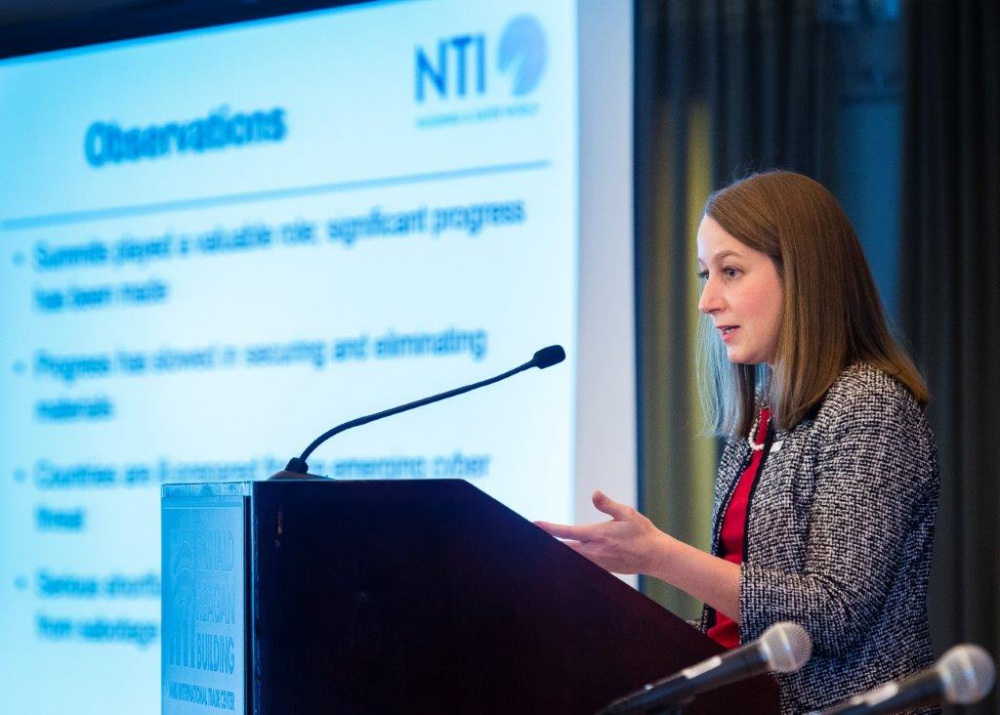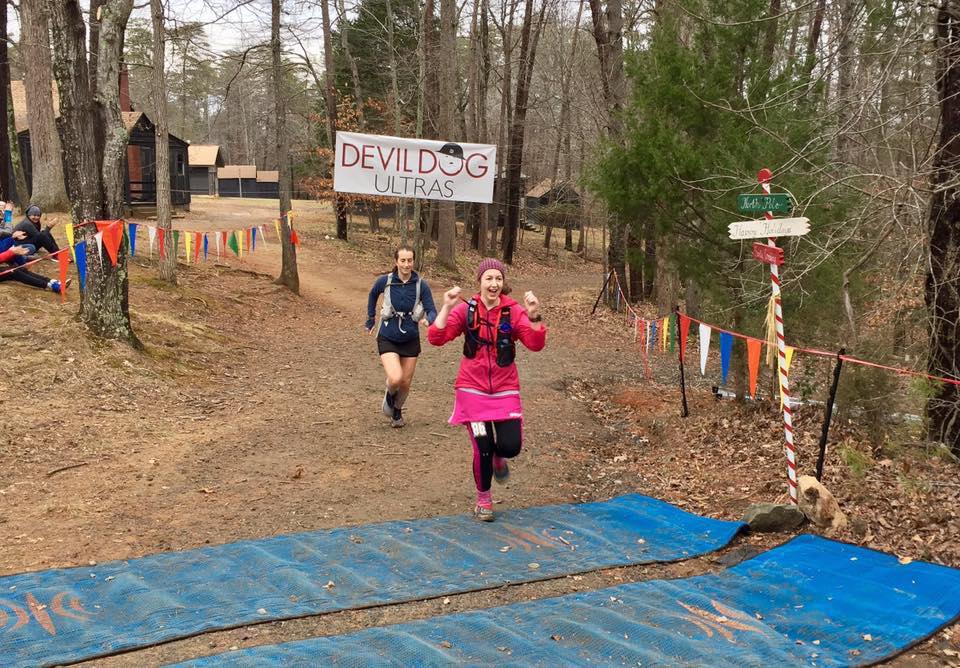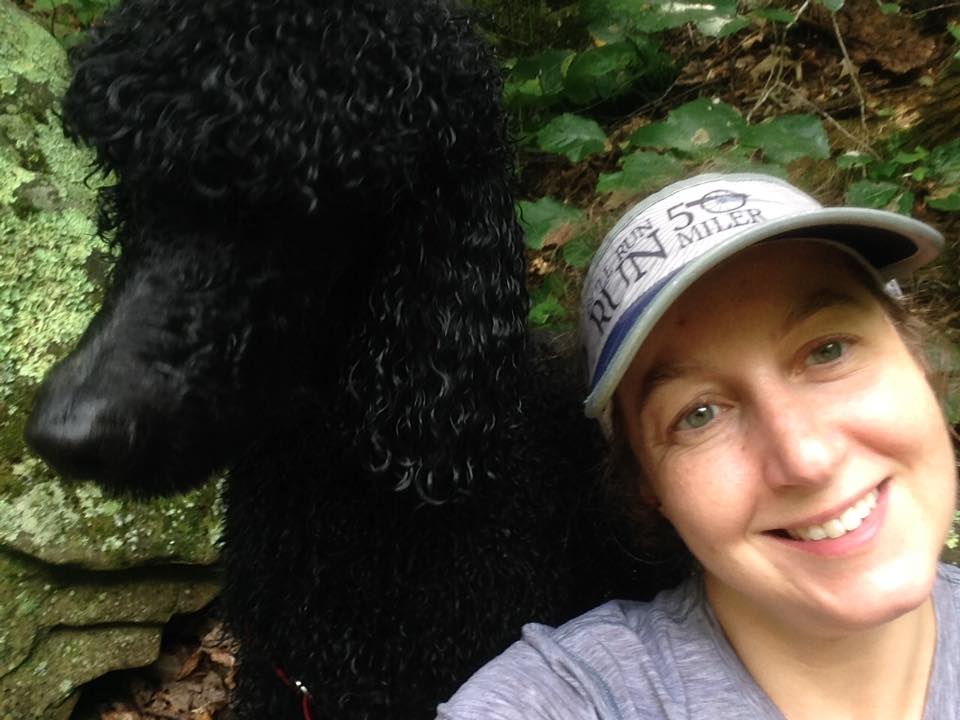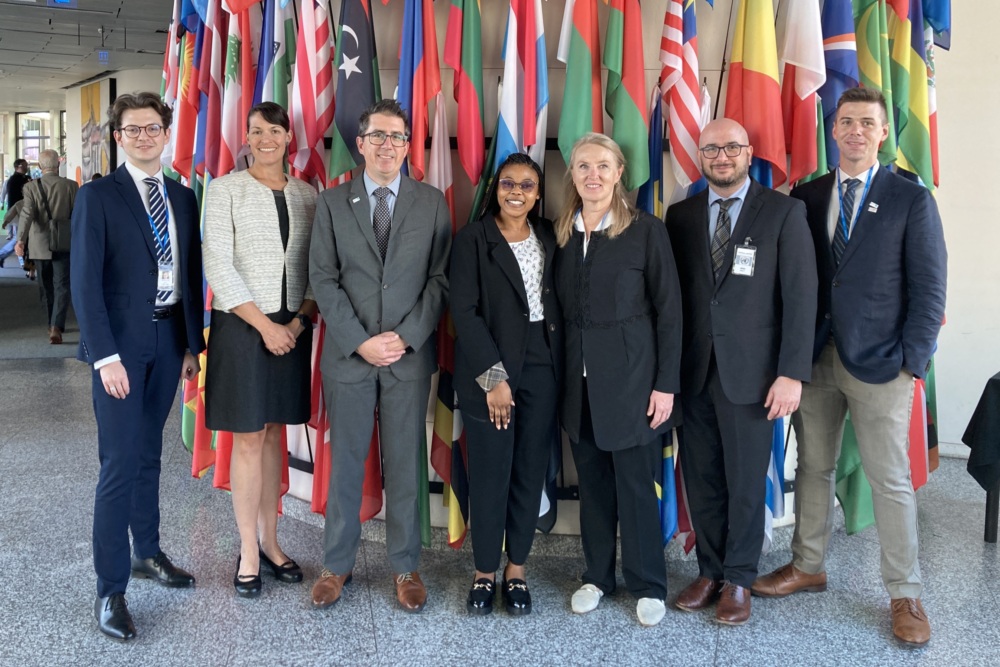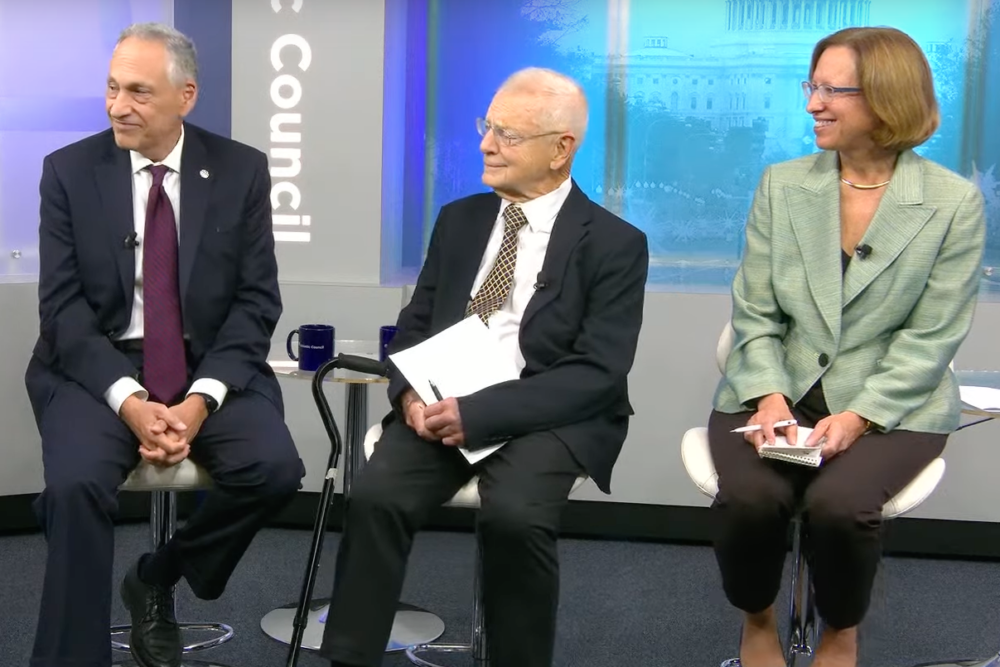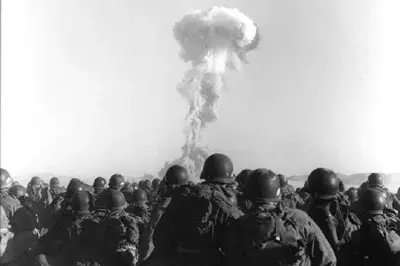
Mimi Hall
Vice President, Communications
Atomic Pulse
Samantha Pitts-Kiefer is Director of NTI’s Global Nuclear Policy Program (GNPP), which works with governments and partners around the
world on the urgent, practical steps toward a world without nuclear weapons.
She also has co-led two major projects: the NTI Nuclear Security Index and the Global Dialogue on Nuclear Security Priorities. Recent work includes cyber security of
nuclear weapons and related systems and nuclear facilities, U.S.-Russia
relations, and nuclear weapons policy and disarmament.
As the director of
the GNPP, you work on the steps toward a long-term goal. Can you talk about
that?
NTI has long advocated for the need to work toward a world without
nuclear weapons. Recognizing that this goal will most likely not be achieved in
any of our lifetimes, we believe it is important to take steps that are
necessary to reach that goal and create the conditions for a world without
nuclear weapons. At NTI, our projects take on many of the conditions, working both
in the U.S. and with international partners in areas such as reducing the role
of nuclear weapons; changing nuclear policies to reduce nuclear risks; encouraging
countries to secure and reduce nuclear materials that could be used by
terrorists; and supporting the universalization and enforcement of
international instruments that would ban testing of nuclear weapons or the
production of nuclear materials for nuclear weapons. So we do a lot of thinking
about reducing nuclear risks and encouraging countries to take steps to reduce
those risks.
You’ve also played a
big role in the development of the NTI Nuclear Security Index and the Global
Dialogue.
The Index and the Global Dialogue are two very,
very different projects but each has its own impact on nuclear security. The
Index is an assessment that has so far been released three times since 2012 to
track and assess the security conditions in countries to prevent acts of nuclear
terrorism—theft of materials or sabotage of a nuclear facility. The Index looks
at specific measures that we think countries should be taking to improve
security conditions for nuclear materials and facilities—from physical security
or cyber security to ratification of treaties and even to things like
corruption in a country. By assessing these conditions and actually scoring and
ranking countries we’ve been able to start a dialogue, a conversation among
countries and experts, about what really matters when it comes to securing
nuclear materials, and we’ve been able to track progress over time. The Index also
helps countries identify what they need to do to improve their security, and we
know of several countries that took certain actions to improve security in
response to the findings in the Index.
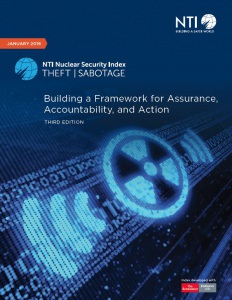
It’s also raised awareness about a new threat—cyber security—which
we included in our 2016 report for the first time, and it really raised
attention to why and how cyber security is important at nuclear facilities. It
generated a lot of interest.
The Global Dialogue project is very different in that we
work directly with government officials from around the world to have a
dialogue about ways to have a more global, systemic approach to improving
nuclear security. This project was started in the context of the Nuclear
Security Summits, which were started by President Obama in 2010—they were held
every two years until 2016. The summits brought together over 50 countries to
find ways to secure and reduce nuclear materials and led to significant
achievements. The Global Dialogue was meant to feed into the summit process by
challenging officials involved in the summits to take off their official hats
and put on their global citizen hats in order to develop interesting, creative
ways to improve security.
What are the big
security challenges facing the Trump administration?
The Trump administration has to face a long, long list of
nuclear challenges. Some of the most obvious ones are going to be ensuring implementation
of the Iran deal, the Joint Comprehensive Plan of Action (JCPOA). Trump and
others in his administration have criticized that deal, but the key will be to
ensure accountability—to ensure that the implementation and verification measures
are working and to hold Iran accountable for living up to the agreement. I
don’t think Trump will actually kill the deal because the alternatives are just
not good—possibly losing support for sanctions amongst our allies, etc. But we
will have to wait and see. The North Korea nuclear program is also going to be
a significant challenge. I think we are all wondering how Trump’s approach is
going to differ from the Obama administration’s.
The Trump administration will also be reviewing U.S. nuclear
policies—in fact he’s already tasked the Secretary of Defense to do so. There
are several elements of nuclear policy that will be part of the review: whether
to maintain the triad of nuclear weapons; how many weapons do we need and can
we make further reductions; will the U.S. reserve the right to use nuclear
weapons first in a conflict or use them for purposes other than to deter a
nuclear attack; are we going to take nuclear weapons off high-alert status to reduce
the risk of accident or miscalculation. Importantly, Trump will need to figure
out how to address the up to $1 trillion modernization plan that the Obama
administration has set in motion. Will Trump roll it back or will he increase
spending on nuclear weapons? So those are going to be very big issues related
to nuclear weapons policy.
He’s also going to have to face the issue of Russia and arms
control. The New START treaty is going to expire at the end of his first term, so
Trump is going to have to consider whether to extend the treaty or to negotiate
a new treaty. His recent statements indicate that he’s willing to negotiate
some kind of arms control deal, but we don’t know what that would look like at
this point (140 characters isn’t exactly long enough to describe serious
policy). We will be looking at how Trump decides to deal with Russia. Will he
try to undertake a broad strategic dialogue with Russia which puts everything
on the table—missile defense, conventional weapons, tactical nuclear weapons?
Another important nuclear challenge will be to continue
making progress on nuclear and radiological security and decide what
initiatives from the Bush and Obama eras to continue or design a new initiative—perhaps
focusing on radiological terrorism and the dirty bomb threat. The radiological
threat has been less of a focus in the last eight years than the nuclear
terrorism threat, even though many experts think a dirty bomb attack is more
likely than a nuclear attack, given the large number of radiological materials
available and the lack of security.
You were not always
in the nuclear security field. You started your career as an attorney practicing
in London. Why the switch?
When I was in law school, I was really passionate about
international law—treaties, international organizations, etc. Instead, I ended
up going into corporate law and practicing mergers and acquisitions and
securities at a law firm in London and New York for a few years. But deep down
I knew that I really wanted to have a career that I found fulfilling and that I
could be passionate about. And while billion-dollar deals can be exciting at times,
my heart just wasn’t in it. So I decided to go back to graduate school,
eventually attending Harvard Kennedy School. While there, I was inspired by
classes with Graham Allison and Matt Bunn and Will Tobey to pursue a career in
nuclear policy. When I first learned in Dr. Allison’s class that a terrorist
could use a nuclear bomb to destroy a city, it truly shocked me, which led me
to getting a summer internship at NTI and eventually coming to NTI full time.
You mentioned that
you worked in London and you’re British, but you have an American accent. Why
is that?
That’s right. My whole family is British, I was born in
England, and I grew up in Oxford. When I was 12, my family moved to Japan for
my dad’s job, and I went to an international school where most people spoke
with an American accent. So I guess I started just absorbing the accent during
that time, and now that I’ve lived in the U.S. for over 20 years, it’s kind of
stuck. But if you hear me talking to my family or if you’re with me in England,
you will definitely hear the English accent coming back. And you’ll still catch
me using British slang once in a while.
Another interesting
thing about you is that you’re a long-distance runner in your free time. Is
that what they’re called? Long-distance runners?
They’re called ultramarathon runners.
So what does that
mean? And what’s the longest distance you’ve run?
Technically an ultramarathon is anything over a
marathon, which is 26.2 miles. Typical distances are 50k, which is about 32
miles; 50 miles; 100k, which is about 61 miles; and 100 miles–and even beyond
that. The longest that I’ve run is 100 miles, which I did in December–it was actually
more like 102 miles when you do the math.
Why would anyone want
to do this?
Well, I started running long distances because I felt that
all of my time was spent pursuing professional challenges, and I decided I
wanted to pursue personal challenges as well. And I had read the book, Born to Run, and was intrigued, so I
joined an ultrarunning club in Virginia called the Virginia Happy Trails
Running Club, and once you start hanging around with these crazy people, who
run these long distances, you start thinking, “Well, maybe I could run 50k or
maybe I could run 50 miles,” and you get a little bit hooked. The challenge
just seemed too enticing not to pursue, and the people in the club and the ultrarunning
community are so welcoming and supportive, you feel like you’ve found a second
family. So I just started out slow … and every time you run a longer distance
you start to feel you can do more, and so it just never ends.
Are you going to run
farther?
My dream is to run the Tahoe 200 miler, which is a race
around Lake Tahoe.
That sounds at least
as hard as getting rid of nuclear weapons.
One of the things you learn from running long distances is
that of course you have to be physically fit, but the majority of what gets you
through these races is the mental aspect. In a long race like a 100-miler, at
some point you’re going to feel that getting to the end is impossible–that it’s
too painful, there are too many obstacles. Maybe there’s a rain storm, maybe
it’s icy, maybe you fall and cut yourself, or maybe you don’t have enough food.
But mentally, you just have to tell yourself to keep moving, step-by-step.
There’s
a phrase that ultra-runners use, which is “Relentless Forward Progress,” and it
means that no matter what, you keep moving forward. If you can’t run, you walk.
If you can’t walk, you shuffle. If you can’t shuffle, you crawl. And eventually,
if you just think step-by-step, you will get to the end. And this can be
applied in any part of life, personal or professional. When you have a goal
like we have, which is working toward a world without nuclear weapons, it seems
like such an enormous goal that you might never get there, but that’s why you
have to work towards it step-by-step,
making relentless forward progress, no matter how slow, no matter how many
obstacles get in your way. You have to keep focusing on the small steps that
will eventually get you there.
Sign up for our newsletter to get the latest on nuclear and biological threats.
Lynn Rusten, vice president of NTI’s Global Nuclear Policy Program, shares her reaction to the 2023 Strategic Posture Report during a panel event at the Atlantic Council.
There is no noise at first, only a flash so bright that the soldiers see their own bones and blood vessels through their skin, as if they have x-ray vision.
